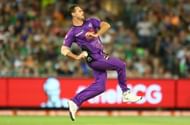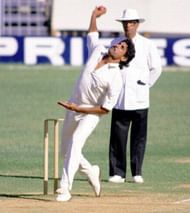Ashish Nehra underwent 12 major surgeries in his 18-year long career. Not many pacers have the same tenacity as Nehra and quit the game in their prime. Nehra is not in the minority. Pick any great pacer from the past 30 years and you would find a file full of X-rays of back, shoulders, knees, and ankles.
'You have to be mad to be fast bowler' - said Shoaib Akhtar, one the most menacing fast bowlers in the history of cricket in an interview. That is true. Knowing the fact that you'll end up with throbbing knees and inflamed shoulders at the end of arduous bowling spells, to opt to be a fast bowler is indeed a kind of madness. There are exceptions though and the 'Haryana Hurricane' - Kapil Dev was one of them.
Throughout his 16-year long career, he remained fit as a fiddle. Kapil Dev always received a clean bill of health from the doctors and never missed a match due to fitness concerns.
In a total of 131 Tests, Kapil Dev played 66 matches at a stretch, missed only one Test in Kolkata (not due to fitness issues), and went on to play the remaining 65 at a stretch. This, in turn, means that the fast bowling all-rounder bowled a mind-boggling 4623.2 overs in international Test cricket without an injury.
The big question is - how?
#1 The Burnout Factor- Not applicable to Kapil Dev?
It is fair to say that the game has become more intense than it was in the 1980s when Kapil Dev played. The number of international playing days has risen sharply. Players these days play around 100 days of international cricket in a year. This, combined with the gruelling schedules of T20 leagues and intense practice sessions, result in stress injuries, especially to fast bowlers.
The key for teams is to utilise the talent pool to great effect in order to increase the longevity of fast bowlers. Having multiple sets of bowlers for different formats will drastically reduce the fatigue. Also, IPL franchises could be directed to give the pacers some break in between.
#2 He was a Mesomorph
Mesomorph is a person with a compact and muscular build.
P S M Chandran of the Sports Authority of India (SAI) gave a detailed account of Kapil Dev's astounding fitness in an interview to DTE. Mesomorphs have a great potential to develop into fast bowlers as they tend to have ideal body weight, good muscle strength, and flexibility.
A series of physiological tests were conducted in 1990 (when Kapil's age was 31 years) for every Indian team member. This included aerobic and motor abilities, pulmonary and cardiovascular health, and fat analysis. Kapil's results showed that even at that age he was amongst the top three fittest players. His fat percentage was in the 13-15% range - perfect for any athlete.
#3 The Science Behind His Bowling Action
A detailed study of the bowling action for the pacers suggests a few key points that normally lead to injuries. Kapil Dev scores highly in all these parameters.
A. The Approach Speed
It is the speed at which the bowler approaches the bowling crease. This has to be optimum, i.e neither too fast nor to slow. Very high approach speeds result in greater ground reaction forces when the back foot and front foot land after the jump.
Kapil Dev did not sprint into the bowling crease and had a very controlled run-up.
B. Leaning Back
Many bowlers tend to lean back while entering their delivery stride, i.e the torso leans back while the body moves forward (Shaun Tait image 2.0). This creates stress on the lower back and the back foot.
As can be seen from the image 1.0 above, Kapil Dev's torso remained pretty much upright.

C. Back Foot Collapse
As shown in image 3.0, the backfoot collapses before the delivery stride due to a combination of approach speed and angle of the run. This results in way too much pressure on the knee and hip joint - the two dearest joints for any fast bowler.
Although in Kapil Dev's case, it does bend slightly (refer image 4.0 below), the time he spent on the back foot was minimal and thus avoided damage.

D. Front Foot Position
It's not just the batsmen who have issues with the front foot. In the case of bowlers, if the front foot is at an angle (pointing towards fine leg), the lower back is handed over the herculean task of twisting the entire body towards the target (facing straight) while it is in motion.
Looking at Kapil Dev's front foot pointing perfectly straight in the image below, it seems he must have been strong in physics.

Thus as a cricketer, Kapil Dev was a naturally strong and flexible personality who always abided by the laws of physics. There is a lot to learn for the young fast bowlers from the bowling maestro.
Follow IPL Auction 2025 Live Updates, News & Biddings at Sportskeeda. Get the fastest updates on Mega-Auction and cricket news
